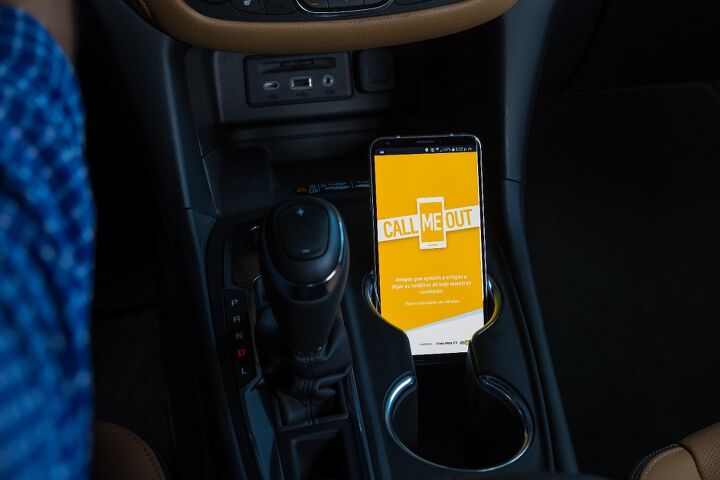Isn't It Ironic: Chevrolet Launches Engaging Phone App Intended to Curb Distracted Driving

Chevrolet is releasing a new smartphone app, titled Call Me Out, to help remind motorists to keep their eyes on the road and put their phones in their pockets while driving. Of course, individuals will still have to check their phones to receive the messages, which seems a little counterintuitive.
While the automaker appears to target “new and experienced drivers,” there’s nothing to indicate the product wouldn’t work equally well for experienced operators. Call Me Out basically functions as a guilt delivery system, using a person’s family and friends for ammunition. Once the app has been installed, the phone’s accelerometer and GPS wait until the car surpasses 5 mph. Then the phone plays recorded, personalized messages from the driver’s loved ones, reminding drivers to keep driving and avoid distractions.
We’d like to applaud General Motors for taking strides to reduce distracted driving, but we can’t really do that when taking the larger picture into consideration.
General Motors, like most automakers, is pushing for increasingly complex infotainment systems and vehicle connectedness. If Chevrolet truly cared about the safety of its customers, it would implement a feature like this on its own vehicles. Instead, it applied it to your personal phone and opened up more opportunities to use proprietary in-car systems. It’s almost diabolically clever, assuming that was the intent.
Besides, anyone old enough to drive will understand how to uninstall this app immediately. Putting Call Me Out on your teenager’s phone is likely to only be helpful if you have a strong rapport with them. However, if that’s the case, then you probably don’t need to go the extra mile to digitally guilt your child into being a safe driver. They’ll have already listened you and will actively attempt not to bring shame upon the family.
The software also seems as though it would be active anytime you are a passenger, meaning there’s likely some simple way to disable it. Otherwise, you’d be left reading a book anytime you hopped in a car with someone or decided to take the bus.
That doesn’t make the app a truly terrible or malicious concept, though. We could see it saving a few lives in the long run and helping build better driving habits among willing participants. If you’re a mature individual that simply has a compulsion to always look at their phone, regular reminders that those close to you don’t want you to die could prove helpful in curbing that behavior.
There is also some “gamification” to encourage users to stick with the app. The less someone handles a phone while driving, the higher the score on the leaderboard. Individuals can then brag to their families about how they’re the safest driver in the group and virtue signal publicly.
GM cited a recent Research Now survey, which claimed 84 percent of people agreed that distracted driving while handling a phone was dangerous, despite 90 percent of drivers admitting to doing so. But we think automotive infotainment can be equally distracting and we’re not alone. AAA Foundation research showed that Apple CarPlay and Android Auto were frequently less distracting for drivers than the infotainment systems found in most new vehicles. However, none devices or systems were deemed truly safe to use while in motion.
“Drivers must use common sense when it comes to technology inside the vehicle. Just because it is available, doesn’t make it safe to use,” said Jake Nelson, AAA director of traffic safety and advocacy. “Smartphone companies and automakers must collaborate to reduce the potential for distraction that technology places on drivers. The airline industry doesn’t compete on safety, and neither should automakers. Motorists deserve better.”
Interested parties can download Call Me Out from the Google Play Store free of charge. However, iPhone users will be out of luck, as GM made no mention of a version compatible with iOS.
[Image: General Motors]

A staunch consumer advocate tracking industry trends and regulation. Before joining TTAC, Matt spent a decade working for marketing and research firms based in NYC. Clients included several of the world’s largest automakers, global tire brands, and aftermarket part suppliers. Dissatisfied with the corporate world and resentful of having to wear suits everyday, he pivoted to writing about cars. Since then, that man has become an ardent supporter of the right-to-repair movement, been interviewed on the auto industry by national radio broadcasts, driven more rental cars than anyone ever should, participated in amateur rallying events, and received the requisite minimum training as sanctioned by the SCCA. Handy with a wrench, Matt grew up surrounded by Detroit auto workers and managed to get a pizza delivery job before he was legally eligible. He later found himself driving box trucks through Manhattan, guaranteeing future sympathy for actual truckers. He continues to conduct research pertaining to the automotive sector as an independent contractor and has since moved back to his native Michigan, closer to where the cars are born. A contrarian, Matt claims to prefer understeer — stating that front and all-wheel drive vehicles cater best to his driving style.
More by Matt Posky
Latest Car Reviews
Read moreLatest Product Reviews
Read moreRecent Comments
- Rover Sig 2021 Jeep Grand Cherokee Limited, like my previous JGC's cheap to keep (essentially just oil, tires) until recent episode of clunking in front suspension at 50K miles led to $3000 of parts replaced over fives visits to two Jeep dealers which finally bought a quiet front end. Most expensive repair on any vehicle I've owned in the last 56 years.
- Bob Hey Tassos, have you seen it with top down. It's a permanent roll bar so if it flips no problem. It's the only car with one permanently there. So shoots down your issue. I had a 1998 for 10 years it was perfect, but yes slow. Hardly ever see any of them anymore.
- 3-On-The-Tree 2007 Toyota Sienna bedsides new plugs, flat tire on I-10 in van Horn Tx on the way to Fort Huachuca.2021 Tundra Crewmax no issues2021 Rav 4 no issues2010 Corolla I put in a alternator in Mar1985 Toyota Land Cruiser FJ60 280,000mi I put in a new radiator back in 08 before I deployed, did a valve job, new fuel and oil pump. Leaky rear main seal, transmission, transfer case. Rebuild carb twice, had a recall on the gas tank surprisingly in 2010 at 25 years later.2014 Ford F159 Ecoboost 3.5L by 80,000mi went through both turbos, driver side leaking, passenger side completely replaced. Rear min seal leak once at 50,000 second at 80,000. And last was a timing chain cover leak.2009 C6 Corvette LS3 Base, I put in a new radiator in 2021.
- ChristianWimmer 2018 Mercedes A250 AMG Line (W177) - no issues or unscheduled dealer visits. Regular maintenance at the dealer once a year costs between 400,- Euros (standard service) to 1200,- Euros (major service, new spark plugs, brake pads + TÜV). Had one recall where they had to fix an A/C hose which might become loose. Great car and fun to drive and very economical but also fast. Recently gave it an “Italian tune up” on the Autobahn.
- Bd2 Lexus is just a higher trim package Toyota. ^^




































Comments
Join the conversation
“The airline industry doesn’t compete on safety, and neither should automakers.” BAHAHAHAHA!!!! Could be because airplanes aren’t “driven” by someone who was given a license to operate simply because they have a pulse. Thousands of barely coherent, distracted Goobs operating 5000 lb. rolling missles within close proximity of each other creates an easy opportunity to “compete on safety” (or at least to pretend to, as is the case with this app).
Ridiculous! Once the phone is tied into the vehicle's Bluetooth/USB network, the phone itself should be mute... the way most other OEMs do it. The bad news is, I'm buying a Chevrolet--just waiting for delivery as it's a special order rather than off-the-lot purchase.